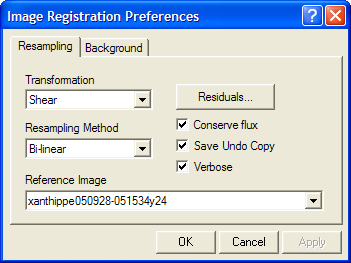To open the Resampling Preferences page,
click ![]() to open the dialog and select the
Resampling tab.
to open the dialog and select the
Resampling tab.
Resampling Preferences Page
Use this page to configure the way images are re-sampled. This page also selects which transformation is being used to achieve registration.
To open the Resampling Preferences page,
click ![]() to open the dialog and select the
Resampling tab.
to open the dialog and select the
Resampling tab.

|
Resampling Preferences |
|
|
Transformation |
Specifies the mathematical mapping between the marker coordinates in the reference image and the target images.
|
|
Resampling method |
Specifies the method used to compute image intensity at fractional pixel coordinates.
|
|
Reference Image |
Select the reference image onto which the transformation mapping is computed. This image is not resampled. |
|
Residuals |
Opens a window listing a table of residuals from the transformation equations in all images. |
|
Conserve Flux |
Check this box to conserve flux (sigma per unit time) in the transformation equations. For example, if conserving flux and the output pixel is 1/2 as wide and 1/2 as tall, then the signal is 1/4 as high. |
|
Verbose |
Check this option to give verbose listing of registration results. |
Use the Shift transformation when there is no significant rotation or scale difference between the images.
Use the Shear transformation then there are scale differences and/or rotational differences between the images.
Use the Bi-cubic resampling option when images have sharp features and many point sources.
Use the Bi-linear option if the bi-cubic filter leaves ringing artifacts. The bi-linear kernel is less sensitive to sharp points but applies more smoothing to the image. For most images, you should choose the Bi-cubic filter.